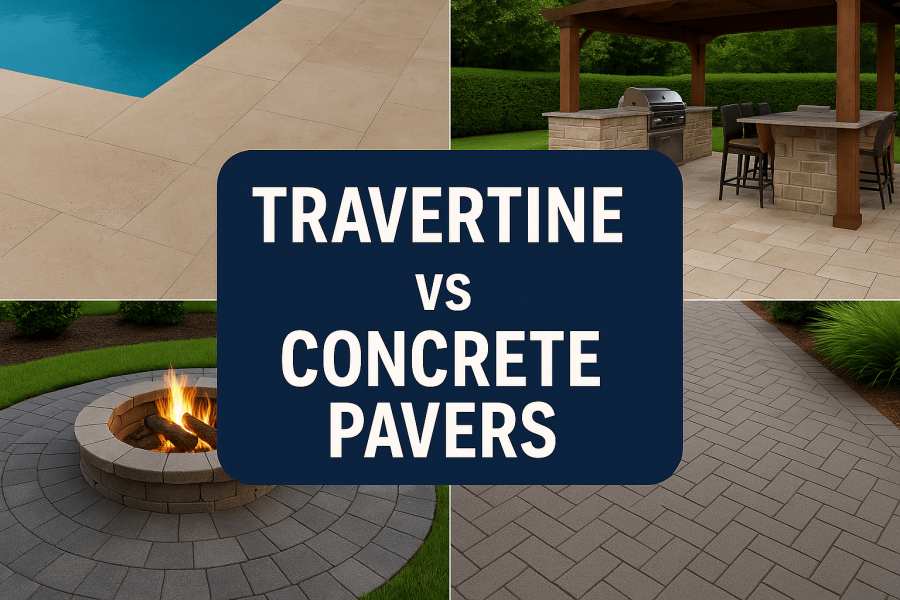- >
St. Augustine Sod
- By: Nicholas Indellicati
- Date: Oct 14 2020
Similar Articles
Artificial Turf vs Sod for Lawns, Backyards & DIY Makeovers
Thinking about artificial turf or sod? Discover the pros and cons of each—from cost and maintenance to durability and pet-friendliness—so you can choose the best option for your lawn or backyard project.
Travertine vs Concrete Pavers for Florida Pool Decks, Patios, Fire Pits & More | bhild
Compare travertine and concrete pavers for Florida pool decks, patios, and driveways — from heat retention and slip resistance to cost, maintenance, and curb appeal.
Beat the Heat: Florida Summer Landscape Survival Guide
Beat the Florida heat with smart summer landscaping. From drought‑tolerant plants to shaded retreats, this guide covers designs, materials, and maintenance tips to keep your yard thriving all season long.
On This Page:
- All about St. Augustine Sod
- What is St. Augustine Sod?
- The History of St. Augustine Sod
- St. Augustine Application
- Pros and Cons of a St. Augustine
- Features of St. Augustine
- pH level of St. Augustine
- General Maintenance for St. Augustine
- Hard Wearing St. Augustine Sod
- Tips for taking care of your Zoysia Sod
- St. Augustine Fertilization
- St. Augustine Sod Costs and Comparison
- Conclusion
All about St. Augustine Sod
Are you about to plan to do a sodding in your yard in the coming days? If yes, you would likely be looking for suitable sod. But, have you thought of the one you are going to select? Thus, there are different types of sods out there. So, choosing the most suitable is challenging. Therefore, you can take St. Augustine Sod as an appropriate sod for your yard.
Without pointing on the difference between the kinds of sods. Can turn your sodding into a terrible one. If you wish to know about St. Augustine, don’t get tense. As we are offering you a complete information guide. Moreover, side-by-side comparison of zoysia sod. So, without any further doing late, let’s get going.
What is St. Augustine Sod?
St. Augustine sod is one of the significantly accepted yard sods in Florida and the Gulf states. Truly, it’s appreciated to its tolerance of heat and humidity. Moreover, its blue-green blades form a dense turf that establishes quickly and easily. Also, it can tolerate salt, making it an excellent choice for coastal yards.
However, only recently has commercially valuable and viable seed for St. Augustine becomes available. So, it typically propagates by plugs, sprigs, or sod. Furthermore, the grass is cultivated; it can reproduce on its own.
The History of St. Augustine
Although St. Augustine sod can be found throughout southern and coastal regions of the US. It is home-grown to the Gulf of Mexico area, the West Indies, and Western Africa. Before 1800, St. Augustine was documented in the West Indies, Brazil, and Bermuda. However, it has been planted for lawns in the state of Florida since the 1890s.
Some of St. Augustine’s most common cultivars include Palmetto, Citra Blue, Floratam, Seville, Raleigh, and Sapphire. Moreover, St. Augustine has been vegetatively propagated for 200 years. So, it means it produces via stolons, plugs, or sod.
Although there are few dwarfs and variegated types of St. Augustine seed. These strains are more attractive and novelty use. Instead of turf grass used for yards—there is no such thing as St. Augustine seed for yards. St. Augustine sods do not produce enough viable seed for commercialization. Subsequently, the source is not made for lawn propagation use, and it is therefore not available for sale at your local garden center.

St. Augustine Palmetto

St. Augustine CitraBlue

St. Augustine Floratam

St. Augustine Seville

St. Augustine Raleigh

St. Augustine Sapphire
The Ultimate FAQs about St. Augustine
How quickly does St. Augustine spread? If you are planting a yard by seed, it can take a long time. Thus, some sources will not even germinate the first year. Let it start by plugs or sprigs planted 6 inches apart. Then it will take at least two years to fill in.
How short should I cut St. Augustine and amount of water?
St. Augustine’s maintenance differs by each season of the year. However, it should generally cut between two to four inches in height. You will trim less in the autumn and winter seasons.
So, leave your St. Augustine yard slightly higher than average at this time. It will encourage more profound root growth for winter. Do this by adjusting the trimmer height settings up to one notch. Moreover, St. Augustine will also need about one inch of water per week, including rainfall.
How do I prevent insects and diseases?
St. Augustine is unprotected to chinch bugs. So, ensure to add a broad-spectrum insecticide. However, if you notice insect damage. Look on for white grubs and a fungus or diseases in St. Augustine in the past. So, prepare to treat your lawn with a systemic fungicide to prevent future outbreaks. Especially in the spring and fall as soil temperatures start to adjust.
St. Augustine is a grass that tends to tolerate shade a little more than most warm-season turf. Since it does well in the shade. So, it becomes more prone to disease with less exposure to sunlight. Thus, it is recommended you apply a fungicide at a preventive rate to keep the damage from occurring.
How do I control weeds in St. Augustine Grass?
As with most turf, it is smart to apply a pre-emergent herbicide in the spring and fall. Thus, it will help suppress weeds. St. Augustine varieties can be sensitive to 2,4–D, an active ingredient commonly found in post-emergent herbicides. If you are noticing weeds in your St. Augustine lawn, apply a post-emergent containing the active ingredient atrazine in it.
How do I prevent thatch in St. Augustine Grass?
St Augustine grass is one of several kinds of grass that can develop thatch. Over-fertilization is one of the biggest reasons in the thatch build-up. Furthermore, soil pH issues can be another. Thatch is acidic. So if required, an application of agricultural limestone will help prevent the development of thatch. Thus, it will help reduce soil acidity.
Subsequently, a soil test will tell you what your soil pH is. Moreover, the third reason for thatch creation is excessive watering. Daily water, regardless of whether it requires it or not, can contribute to thatch.
How often should I fertilize St. Augustine grass?
Indeed, fertilizing established St. Augustine yard is essential to get the nutrients it needs. Further, if your soil is slightly acidic, be sure to apply a fertilizer with iron and other micronutrients.
St Augustine sod needs approximately 4 to 5 lbs. nitrogen per 1000 sq. ft. per year. However, if the grass is being started with a plug or with stolons, apply 1 lb. nitrogen per 1000 sq. ft. Thus, apply each month during the growing season. So, this will promote the fastest growth and spread. Yet, established sod only needs 4 to 5 pounds annually.
Over-fertilization of established sod only encourages thatch, insect, and disease problems. Fertilization can be confusing for many people. However, it is essential to know the requirement of nitrogen; to maintain a good fertility program. We have made it easy to understand.
Pros and Cons of St. Augustine
Pros
- It performs better in the shade than other warm-season turfs.
- Tolerates coastal, saline soil,
- Compared to other warm-season grasses, it holds its color well in drought conditions.
- Possesses a dense growth that outcompetes weeds,
- Tolerates moderate foot traffic and has a perfect injury recovery.
- Possesses an excellent spring green-up when coming out of dormancy.
- It performs well in hot, tropical climates.
Cons
- Does not perform well in colder weather,
- Less likely to survive prolonged drought,
- Moreover, this sod does not handle high traffic as well as other warm-season grasses.
- Vulnerable to pests and diseases,
- Augustine creates thatch due to over-fertilization.
Features of St. Augustine
- Augustine is coarse-textured with a very thick grass blade that rounds at the top. So, it becomes more flattened towards the soil.
- It is dark green with broad, flat blades that can form a thick grass layer.
- Unlike Bermuda, it’s rival in the warmer climates and tropics of the United States.
- Moreover, it does not have rhizomes.
- Augustine is a stoloniferous species that root at the nodes.
- It is tolerant of high summer temperatures. Hence, it can keep its color at temperatures as much as 10 degrees lower than Bermuda.
- Augustine is one of the best shade-tolerant sods of its warm season family.
- Furthermore, it flourishes in irrigated areas with good drainage.
- Augustine sod is also highly tolerant of soil coarseness—salty soils. In contrast, to zoysia or Bermuda grass.
- Indeed, it can grow in a wide range of soil types.
General Maintenance for St. Augustine
St. Augustine’s maintenance differs by each season of the year. However, it should generally cut between two to four inches in height. You will trim less in the autumn and winter seasons.
So, leave your St. Augustine yard slightly higher than average at this time. It will encourage more profound root growth for winter. Do this by adjusting the trimmer height settings up to one notch. Moreover, St. Augustine will also need about one inch of water per week, including rainfall.
Hard-wearing St. Augustine Sods
Yet, we have added nutrients to the St. Augustine turf in the form of fertilizers. So, we have stopped using the area for any wear and tear during the repair phase. Thus, we have ensured the yard is getting appropriately watered. Moreover, it receives the most benefit from that watering by applying wetting agents and sprayed for any heavy weed infestations.
Within a few weeks, one can see some improvements to our Saint Augustine lawn. Next, it’s time to adjust our lawn mowing practices.
Fertilization Requirements of St. Augustine Sod
Indeed, fertilizing established St. Augustine yard is essential to get the nutrients it needs. Further, if your soil is slightly acidic, be sure to apply a fertilizer with iron and other micronutrients.
St Augustine sod needs approximately 4 to 5 lbs. nitrogen per 1000 sq. ft. per year. However, if the grass is being started with a plug or with stolons, apply 1 lb. nitrogen per 1000 sq. ft. Thus, apply each month during the growing season. So, this will promote the fastest growth and spread. Yet, established sod only needs 4 to 5 pounds annually.
Over-fertilization of established sod only encourages thatch, insect, and disease problems. Fertilization can be confusing for many people. However, it is essential to know the requirement of nitrogen; to maintain a good fertility program. We have made it easy to understand.
Cost Comparison:
A lot of homeowners are installing sod instead of grass. It is because of cutting down on maintenance and ongoing expenses. Fortunately, there are numerous kinds of sod to choose from them. All have their advantages and disadvantages. Thus, as most remodeling projects do, the selection will largely depend on cost. Luckily, we have researched the average St. Augustine costs below:
Note: Prices above are for materials only. Thus, they do not include installation.
The Conclusion:
Summing up, there’s no reason to delay your St. Augustine Sod project any longer. Materials are inexpensive. Yet, installation and nurture times are low. While some self-built, others like the peace of mind. That comes with hiring professionals.
In the end, we are hopeful that our take on a side-by-side guide regarding a St. Augustine Sod would help you in choosing the one that suits your priorities.





